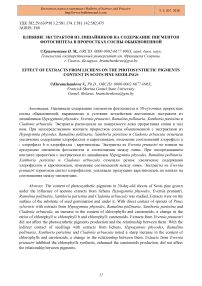Влияние экстрактов из лишайников на содержание пигментов фотосинтеза в проростках сосны обыкновенной
Автор: Храмченкова О. М.
Журнал: Бюллетень науки и практики @bulletennauki
Рубрика: Биологические науки
Статья в выпуске: 7 т.4, 2018 года.
Бесплатный доступ
Оценивали содержание пигментов фотосинтеза в 30-суточных проростках сосны обыкновенной, выращенных в условиях воздействия ацетоновых экстрактов из лишайников Hypogymnia physodes, Evernia prunastri, Ramalina pollinaria, Xanthoria parietina и Cladonia arbuscula. Экстракты располагали на поверхности ложа прорастания семян и под ним. При непосредственном контакте проростков сосны обыкновенной с экстрактами из Hypogymnia physodes, Ramalina pollinaria, Xanthoria parietina и Cladonia arbuscula отмечали увеличение содержания хлорофиллов и каротиноидов, изменение соотношений хлорофилл a : хлорофилл b и хлорофиллы : каротиноиды. Экстракты из Evernia prunastri не влияли на продукцию пигментов фотосинтеза и соотношения между ними. При опосредованном контакте проростков с экстрактами из лишайников Hypogymnia physodes, Ramalina pollinaria, Xanthoria parietina и Cladonia arbuscula отмечали резкое увеличение содержания хлорофиллов и каротиноидов, изменение соотношений между ними. Экстракты из Evernia prunastri тормозили синтез хлорофиллов, усиливали продукцию каротиноидов, не влияли на соотношения между пигментами.
Лишайники, Hypogymnia physodes, Evernia prunastri, Ramalina pollinaria, Xanthoria parietina, Cladonia arbuscula, ацетоновые экстракты, сосна обыкновенная, проростки, пигменты фотосинтеза, хлорофиллы, каротиноиды
Короткий адрес: https://sciup.org/14110347
IDR: 14110347 | УДК: 582.29:630*813.2:581.174.1:581.142:582.475 | DOI: 10.5281/zenodo.1312147
Фрагмент статьи Влияние экстрактов из лишайников на содержание пигментов фотосинтеза в проростках сосны обыкновенной
The content of photosynthetic pigments in 30-day-old shoots of Scots pine grown under the influence of acetone extracts from lichens Hypogymnia physodes, Evernia prunastri, Ramalina pollinaria, Xanthoria parietina and Cladonia arbuscula was studied. Extracts were on the surface of the substrate of seed germination and under it. With direct contact of sprouts of Pinus sylvestris with extracts from Hypogymnia physodes, Ramalina pollinaria, Xanthoria parietina and Cladonia arbuscula, an increase in the content of chlorophylls and carotenoids, a change in the ratios of chlorophyll a: chlorophyll b and chlorophyll: carotenoids. Extracts from Evernia prunastri did not affect the photosynthetic pigments production and the relationship between them. With the indirect contact of seedlings with extracts from lichens, Hypogymnia physodes, Ramalina pollinaria, Xanthoria parietina and Cladonia arbuscula noted a sharp increase in the content of chlorophylls and carotenoids, a change in the relationship between them. Extracts from Evernia prunastri inhibited the chlorophylls synthesis, enhanced the carotenoids production, did not affect the relationship between pigments.
Текст научной статьи Влияние экстрактов из лишайников на содержание пигментов фотосинтеза в проростках сосны обыкновенной
Бюллетень науки и практики / Bulletin of Science and Practice Т. 4. №7. 2018
Механизмы взаимодействия лишайников и высших растений далеки от понимания. Существуют две противоположные точки зрения: лишайники обильно развиваются там, где высшие растения не составляют им конкуренции в фитоценозе; лишайники за счет наличия в их талломах специальных метаболитов не только защищаются от воздействия факторов внешней среды, но и подавляют рост соседствующих с ними бактерий, грибов и даже проростков высших растений. Известен ряд работ, посвященных аллелопатическим свойствам лишайников, где описывают процессы подавления лишайниками всхожести семян, развития микоризы, деградации хлорофилла [1–4].
В естественных условиях прорастание семян древесных пород зачастую бывает сопряжено с присутствием биомассы лишайников разных видов — как эпигейных и эпиксильных, так и эпифитных (попадающих на поверхность лесной подстилки с опадом коры и веток деревьев). Ранее было показано, что присутствие биомассы лишайников влияет на энергию прорастания и всхожесть семян древесных пород, в том числе: сосны обыкновенной [5]. Вместе с тем, лесная подстилка является средой, где из лишайников выщелачиваются водорастворимые соединения, представляющие собой набор однозамещенных фенолов [6]. Собственно вторичные метаболиты лишайников в таких условиях не извлекаются, так как подавляющее большинство их них не переходит в водные растворы даже такого сложного состава, каковым является влага лесной подстилки. Вторичные метаболиты извлекаются из биомассы лишайников с использованием ацетона, метанола, хлороформа, этанола, диэтилового эфира, гексана, бензола, дихлорметана, петролейного эфира, этилацетата и некоторых других растворителей [7–13]. Любой из упомянутых растворителей извлекает из биомассы лишайников не только собственно вторичные метаболиты, но и смесь веществ, содержащую все соединения, способные растворяться в нем при условиях экстрагирования. Представляется актуальным оценить влияние экстрактов из лишайников на ассимиляционный аппарат проростков сосны обыкновенной.
У хвойных первичный ассимиляционный аппарат проростков представлен семядолями и, частично, гипокотилем, которые являются специализированным фотосинтезирующим органом, не выполняющим резервных функций. Семядоли выглядят как хвоинки, образующие мутовку на верхушке стволика проростков. Их количество непрерывно возрастает за счет деятельности апикальной меристемы первичного побега. Содержание в проростках хлорофиллов и каротиноидов является показателем их физиологического состояния.
Методы исследований
Для исследования были выбраны пять видов лишайников: гипогимния вздутая Hypogymnia physodes (L.) Nyl. (Syn. Parmelia physodes (L.) Ach.), эверния сливовая Evernia prunastri (L.) Ach. рамалина пыльцеватая Ramalina pollinaria (Westr.) Ach., ксантория настенная Xanthoria parietina (L.) Th. Fr. и кладония лесная Cladonia arbuscula (Wallr.) Flot.
Бюллетень науки и практики / Bulletin of Science and Practice Т. 4. №7. 2018
(Syn. Cladonia sylvatica (L.) Hoffm.). Биомассу лишайников и семена сосны обыкновенной отбирали на территории Государственного лесохозяйственного учреждения «Гомельский лесхоз» на типичных для каждого вида субстратах.
Экстракцию лишайников проводили ацетоном в аппарате Сокслета, полноту экстракции контролировали стандартным способом [14]. Растворитель отгоняли на ротационном испарителе, экстракты высушивали.
Навески экстрактов из лишайников брали с учетом химического выхода экстрактов и результатов, изложенных в [5] — 1,02 10-4 г экстракта на 1 см2 ложа для проращивания семян. Экстракты растворяли в ацетоне, фильтровали, в фильтрат помещали подложки из фильтровальной бумаги для проращивания семян; постоянно перемешивая, выдерживали до полного испарения растворителя. Для контрольных опытов использовали аналогичные подложки из фильтровальной бумаги, вымоченные приведенным выше способом в чистом ацетоне.
Семена сосны обыкновенной проращивали 30 суток при естественном освещении в пластиковых контейнерах при температуре 22±2 °С. Для каждого варианта опытов проращивали по 50 семян в трехкратной повторности, для увлажнения использовали смесь Кнопа, разведенную водой в соотношении 1:10. В первой серии опытов семена раскладывали на ложе, верхний слой которого представлял собой подложку, пропитанную экстрактом из одного из видов лишайников. Во второй серии опытов подложку, пропитанную экстрактом из лишайников, помещали под верхний слой фильтровальной бумаги. Схема эксперимента приведена в Таблице.
ШИФРЫ ОПЫТНЫХ СЕРИЙ
Таблица.
|
Виды лишайников |
Подложки с экстрактами из лишайников являются ложем для прорастания семян |
Подложки с экстрактами из лишайников расположены под ложем для прорастания семян |
|
Hypogymnia physodes |
H |
H’ |
|
Evernia prunastri |
E |
E’ |
|
Ramalina pollinaria |
R |
R’ |
|
Xanthoria parietina |
X |
X’ |
|
Cladonia arbuscula |
Cl |
Cl’ |
После завершения проращивания зеленую часть проростков (семядоли и часть гипокотиля) отделяли, пробу усредняли, и использовали для определения пигментов фотосинтеза. Навеску биомассы проростков сосны обыкновенной экстрагировали ацетоном. Определение содержания хлорофиллов a , b и каротиноидов проводили с использованием спектрофотометра Solar 2201. Измеряли оптическую плотность растворов при длинах волн 440,5; 644 и 662 нм. Для вычисления концентрации хлорофиллов и каротиноидов использовали формулы Реббелена [15]. Полученные результаты пересчитывали на 1 г сырой массы проростков. Вычисляли также величины отношений концентраций: C хлa /C хл b и C хл a +хл b /C кар . Результаты обрабатывали с использованием стандартного программного продукта Статистика 7.0.
Результаты и их обсуждение
Исследования пигментов фотосинтеза растений играют важную роль для понимания характера их «ответа» на условия окружающей среды. Содержание хлорофиллов и каротиноидов — главных фоторецепторов фотосинтезирующей клетки — является одним из показателей реакции растений на изменение факторов внешней среды, степени их адаптации к новым экологическим условиям. Для характеристики функционального состояния растений наиболее информативными считаются показатели фотосинтетического аппарата, а среди них состав, содержание и соотношение пигментов.
Измерение концентраций пигментов фотосинтеза в 30-суточных проростках сосны обыкновенной, выращенных в условиях воздействия экстрактов из лишайников, выявило наличие значимых отличий между вариантами — Рисунки 1–3.
При выращивании всходов сосны обыкновенной на подложках, содержащих экстракты из Hypogymnia physodes , Ramalina pollinaria, Xanthoria parietina и Cladonia arbuscula , содержание хлорофилла a в зеленой части проростков возрастало на 11,4÷35,2% по сравнению с контролем — Рисунок 1а; содержание хлорофилла b превышало контрольные значения на 15,3÷70,0% — Рисунок 2а; каротиноидов — на 13,8÷49,0% — Рисунок 2а.
При воздействии экстрактов из Evernia prunastri концентрация пигментов фотосинтеза достоверно не отличалась от значений, установленных для контрольных образцов.
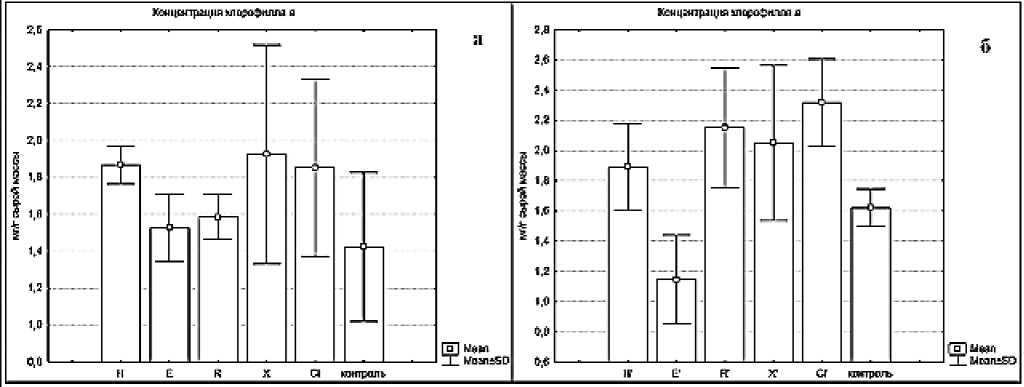
Рисунок 1. Содержание хлорофилла a в проростках сосны обыкновенной.
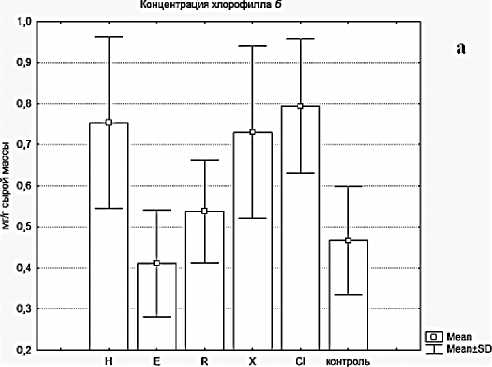
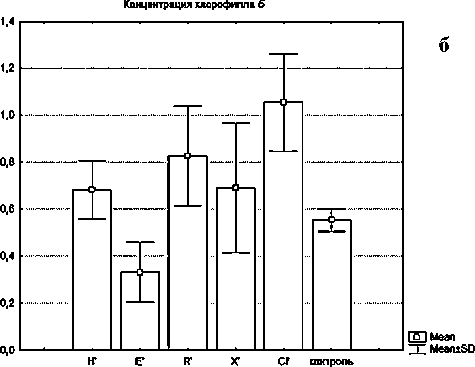
Рисунок 2. Содержание хлорофилла b в проростках сосны обыкновенной.
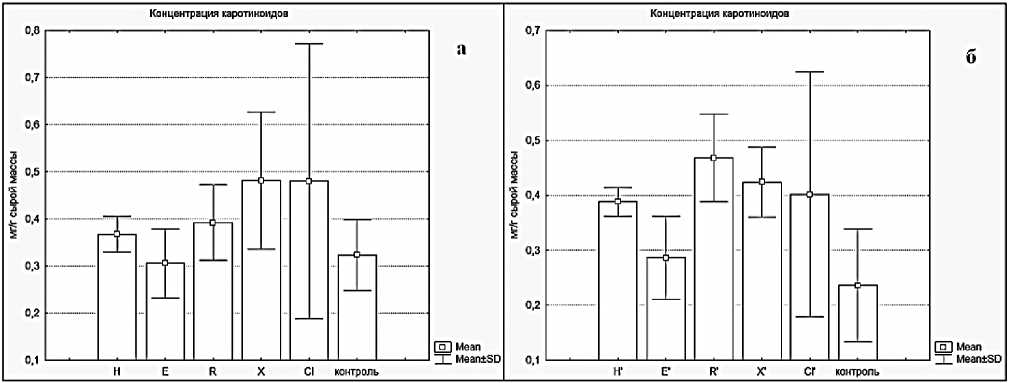
Рисунок 3. Содержание каротиноидов в проростках сосны обыкновенной.
При выращивании всходов сосны обыкновенной в сериях опытов, где подложки с экстрактами из Hypogymnia physodes , Ramalina pollinaria, Xanthoria parietina и Cladonia arbuscula находились под верхним слоем фильтровальной бумаги, в зеленой части проростков также имело место возрастание концентрации пигментов фотосинтеза: хлорофилла a — на 16,6÷43,1%; хлорофилла b — на 23,2÷90,4%; каротиноидов — на 60,5% — Рисунки 2б, 4б и 4б. При воздействии экстрактов из Evernia prunastri концентрация хлорофиллов была ниже контрольных значений на 23,3÷40,2%; каротиноидов — выше на 21,3%.
Соотношение концентраций a и b в тканях растений и отношение их суммы к содержанию каротиноидов являются показателями физиологического состояния растений и, в известной степени, индикаторами стресса. Высокая концентрация хлорофилла характерна для здоровых растений, тогда как содержание каротиноидов, как правило, увеличивается у растений, подверженных стрессу. У растений отношение хлорофиллов а и б составляет примерно 3:1. Отношение хлорофиллы/каротиноиды составляет 4,5÷5,0, хотя может варьировать в пределах 4,3÷8,0. Высокая величина соотношения хлорофиллы : каротиноиды свидетельствует об удовлетворительном физиологическом состоянии растений: снижение величины этого показателя свидетельствует о снижении физиологического статуса растений, вызванном воздействием внешних факторов.
На Рисунках 5 и 6 приведены результаты расчетов отношения хлорофиллов a и b, а также отношения хлорофиллы/каротиноиды в 30-суточных проростках сосны обыкновенной, выращенных в условиях воздействия на них экстрактов из лишайников.
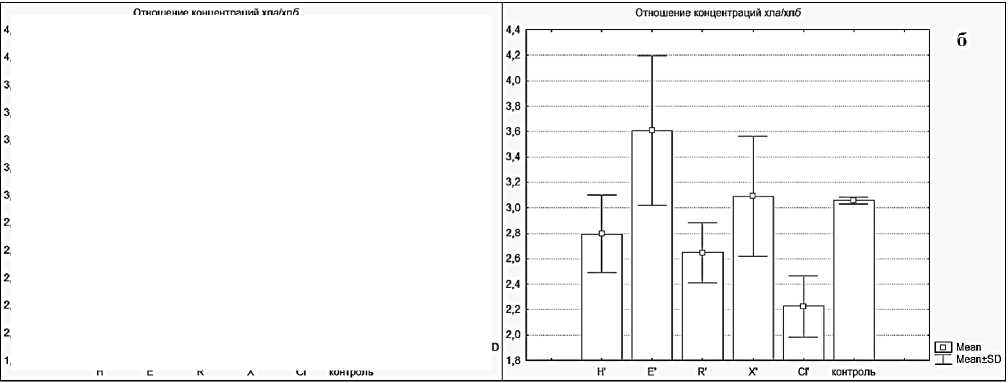
Рисунок 4. Отношение концентраций хлорофиллов а и б в проростках сосны обыкновенной.
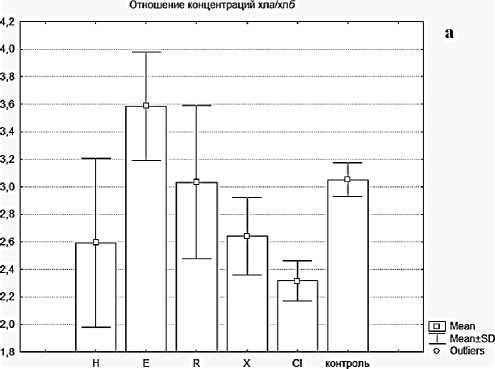
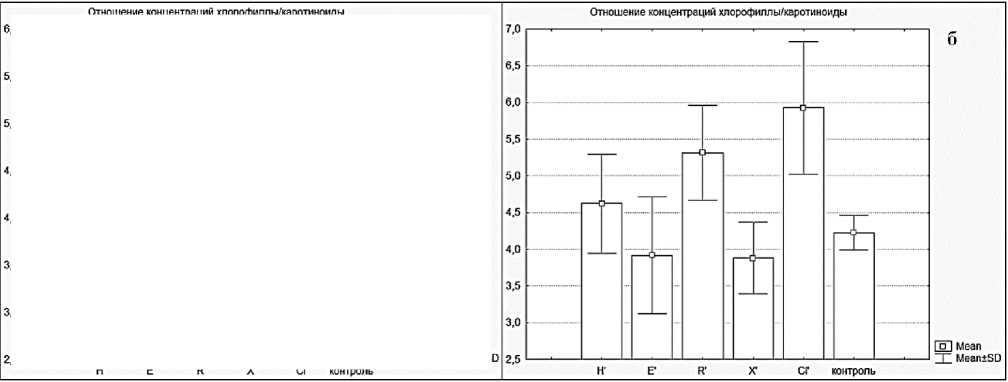
Рисунок 5. Отношение концентраций хлорофиллы/каротиноиды в проростках сосны обыкновенной.
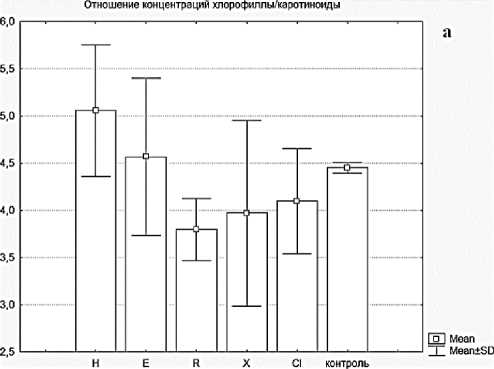
При выращивании всходов сосны обыкновенной на подложках, содержащих экстракты из Ramalina pollinaria и Evernia prunastri соотношение концентраций хлорофиллов a и b выглядит вполне «благополучным» — Рисунок 5а. Вместе с тем, в случае присутствия экстрактов из Hypogymnia physodes , Xanthoria parietina и Cladonia arbuscula , несмотря на значительное увеличение содержания хлорофиллов в проростках, соотношение между ними свидетельствует об изменении структуры светопоглощающего комплекса проростков. О тенденции развития стресса у проростков сосны обыкновенной свидетельствуют данные Рисунка 6а: в присутствии экстрактов из Ramalina pollinaria, Xanthoria parietina и Cladonia arbuscula соотношение хлорофиллы : каротиноиды понижено.
При выращивании всходов сосны обыкновенной в сериях опытов, где подложки с экстрактами из Cladonia arbuscula находились под верхним слоем фильтровальной бумаги, в зеленой части проростков соотношение хлорофиллов также было анормальным, и составляло 2,2 — Рисунок 5б. В остальных сериях опытов данное соотношение было близко к оптимальному. Можно говорить о тенденции развития стресса в случае присутствия экстрактов из Evernia prunastri и Xanthoria parietina : соотношение хлорофиллы/каротиноиды понижено.
Выводы
При выращивании всходов сосны обыкновенной на подложках, содержащих ацетоновые экстракты из лишайников, отмечены следующие эффекты. Экстракты из Hypogymnia physodes резко усиливали продукцию пигментов фотосинтеза, сохраняя при этом соотношения концентраций хлорофиллов и каротиноидов близкими к оптимальным. Экстракты из Evernia prunastri не влияли на продукцию пигментов фотосинтеза, сохраняя при этом соотношения концентраций хлорофиллов и каротиноидов близкими к оптимальным. Экстракты из Ramalina pollinaria умеренно усиливали продукцию пигментов фотосинтеза, сохраняя при этом соотношения концентраций хлорофиллов и каротиноидов близкими к оптимальным. Экстракты из Xanthoria parietina резко усиливали продукцию пигментов фотосинтеза, понижая величины отношений их концентраций. Экстракты из Cladonia arbuscula резко усиливали продукцию пигментов фотосинтеза, понижая величины отношений их концентраций.
При проращивании семян сосны обыкновенной в сериях опытов, где подложки с экстрактами из лишайников находились под верхним слоем фильтровальной бумаги, отмечены следующие эффекты. Экстракты из Hypogymnia physodes умеренно усиливали продукцию пигментов фотосинтеза (кроме каротиноидов), сохраняя при этом соотношения концентраций хлорофиллов и каротиноидов близкими к оптимальным. Экстракты из Evernia prunastri резко тормозили синтез хлорофиллов, усиливали продукцию каротиноидов, сохраняя при этом соотношения концентраций хлорофиллов и каротиноидов близкими к оптимальным. Экстракты из Ramalina pollinaria резко усиливали продукцию пигментов фотосинтеза, особенно — каротиноидов, изменяя величины отношений их концентраций. Экстракты из Xanthoria parietina резко усиливали продукцию пигментов фотосинтеза, особенно каротиноидов, сохраняя при этом соотношения концентраций хлорофиллов и каротиноидов близкими к оптимальным. Экстракты из Cladonia arbuscula резко усиливали продукцию пигментов фотосинтеза, изменяя величины отношений их концентраций.
Список литературы Влияние экстрактов из лишайников на содержание пигментов фотосинтеза в проростках сосны обыкновенной
- Sedia E. G., Ehrenfeld J. G. Lichens and mosses promote alternate stable plant communities in the New Jersey Pinelands // Oikos. 2003. V. 100. №3. P. 447-458.
- Favero-Longo S. E., Piervittori R. Lichen-plant interactions // Journal of Plant Interactions. 2010. V. 5. №3. P. 163-177.
- Stark S. Hyvärinen M. Are phenolics leaching from the lichen Cladina stellaris sources of energy rather than allelopathic agents for soil microorganisms? // Soil Biology and Biochemistry. 2003. V. 35. №10. P. 1381-1385.
- Latkowska E., Chrapusta E., Bober B., Kaminski A., Adamski M., Bialczyk J. Allelopathic effects of epiphytic lichen Hypogymnia physodes (L.) Nyl. colonization on the spruce (Picea abies (L.) Karst.) bark // Allelopathy Journal. 2015. V. 35. №1. P. 129-138.
- Храмченкова О. М. Влияние биомассы лишайников на прорастание семян сосны обыкновенной (Pinus sylvestris L.) и березы повислой (Betula pendula Roth.) // Проблемы лесоведения и лесоводства: сб. н. т. ИЛ НАН Беларуси. 2017. Вып. 77. С. 396-402.
- Zagoskina N. V., Nikolaeva T. N., Lapshin P. V., Zavarzin A. A., Zavarzina A. G. Water-soluble phenolic compounds in lichens // Микробиология. 2013. Т. 82. №4. С. 445-452.
- Studzińska-Sroka E., Piotrowska H., Kucińska M., Murias M., Bylka W. Cytotoxic activity of physodic acid and acetone extract from Hypogymnia physodes against breast cancer cell lines // Pharm Biol. 2016. V. 54. №11. P. 2480-2485.
- Stojanović I., Radulović N., Cvetković V., Mitrović T., Stamenković S. Antimicrobial activity of methanol extracts of four Parmeliaceae lichen species // Facta universitatis-series: Phys Chem Technol. 2013. V. 11. №1. P. 45-53.
- Rashmi S., Rajkumar H. G. Evaluation of antifungal activity of lichen extracts against phytopathogenic fungi Macrophomina phaseolina (Tassi) Goid // International Journal of Current Research. 2015. V. 7. №7. P. 17718-17721.
- Bézivin C., Tomasi S., Lohézic-Le Dévéhat F., Boustie J. Cytotoxic activity of some lichen extracts on murine and human cancer cell lines // Phytomedicine. 2003. V. 10. P. 499-503.
- Joulain D., Tabacchi R. Lichen extracts as raw materials in perfumery. Part 1: oakmoss // Flavour Fragr. J. 2009. V. 24. P. 49-61.
- Sharma A. K., Sharma K. K., Sharma M. C., Dobhal M. P. Two Dibenzofuran identified as Heterocyclic Natural Compounds from Lichen Parmelia perlata // Journal of Pharmacognosy and Phytochemistry. 2014. V. 2. №5. P. 95-97.
- Nasser J. A., Yaacob W. A., Din L. B., Yamin B. M., Latip J. Isolation of atranorin, bergenin and goniothalamin from Hopea sangal // ARPN Journal of Engineering and Applied Sciences. 2009. V. 4. №1. P. 92-95.
- Воробьев В. Н. Невмержицкая Ю. Ю., Хустнетдинова Л. З., Якушенкова Т. П. 2013. Практикум по физиологии растений: учебно-методическое пособие. Казань: Казанский университет. 80 с.

